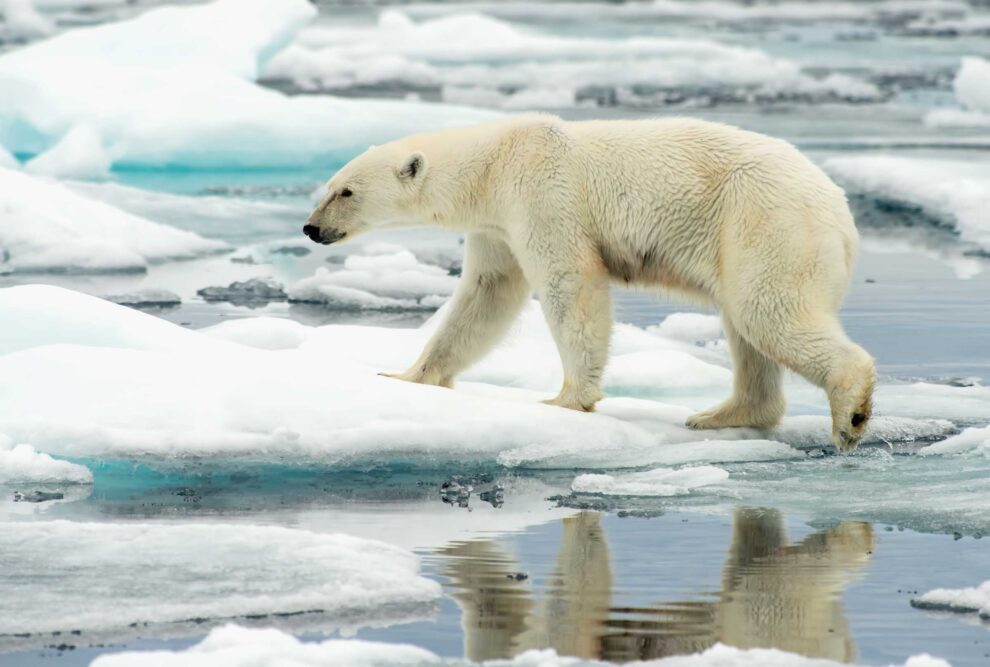For some cruisers, a sailing to the Arctic is all about seeing the vast, untamed landscapes, which are somehow eerie and beautiful at the same time. Snow-capped mountains, thick, sometimes-unpassable ice, and low-hanging mists make the region mysterious and memorable.
But for others, an Arctic cruise is all about polar bear spotting. A cruise to the Artic will spend time in Svalbard, one of the best places to spot these magnificent creatures in the wild. A Svalbard polar bear cruise is part of the reason Arctic cruising is continuing to gain in popularity as an expedition destination.
Count us among the cruisers who fall into the latter category. One of the things we were most excited about on our first Arctic cruise – on Lindblad’s National Geographic Resolution – was the possibility of seeing a polar bear in the wild.
Our cruise delivered (on Day 2!), but will you actually see a polar bear on your Arctic cruise? The answer isn’t necessarily a simple one.
Will I See Polar Bears on My Arctic Cruise?

Your best chance of seeing a polar bear is on the ice in the Arctic. (Photo: Colleen McDaniel)
So, will I see polar bears on my cruise to the Arctic? Maybe. Polar bears are only found in the very north of the world – north of the Arctic Circle to the North Pole, exactly where an Arctic cruise sails. (Don’t look for polar bears on your cruise to Antarctica; you’ll be disappointed.)
Just by sailing, you’ll have a decent chance of seeing these elusive creatures. But it’s certainly not a guarantee. After all, you’re looking for white bears against a landscape that is predominantly covered in white snow and ice. Polar bears also move quickly, and they’re excellent swimmers, thanks to flat feet with webbing between the toes. In the water, all you’ll see is their black heads, which, from a distance, can easily be confused for a swimming bird.
The largest carnivorous mammals on the planet live and spend their time on annual Arctic sea ice – which is shrinking these days – so you’re more likely to see a polar bear on the ice than on land. Their diet, which primarily consists of seal blubber, means you can see them hunting from the ice sheet.
If you’re set on seeing a polar bear on your Artic cruise, increase your odds by booking on a ship that has ice-breaking technology, allowing it to sail farther north, breaking up the annual ice sheet, which melts. We sailed on National Geographic Resolution, which has an X-bow design that allows it to easily cut through that first-year ice year-round. (It has a polar class rating of PC 5 Category A. Polar classes range from the lowest – PC 7 – to highest – PC 1, which can withstand year-round operations in all polar regions. Several other cruise lines offer ships with PC 6 ratings, which will also cut through the ice in the summer and autumn.) Multiple cruise lines offer ships with ice-breaking technology, including Viking, Hurtigruten, Atlas Ocean Voyages, Scenic, Swan Hellenic and Ponant.
Where and when you cruise also matters. Svalbard, the Norwegian archipelago located between the Norwegian mainland and the North Pole that has a significant polar bear population, is the starting point for many Arctic cruises. The summer months, particularly June and July, when the ice begins to recede, offer better visibility, though dense fog still is a reality on a Svalbard polar bear cruise. The sun doesn’t really set during this time, so you’ve got daylight – and the opportunity for wildlife viewing – even in the wee hours.
Expedition Guides and Keeping a Sharp Eye Out

Passengers on National Geographic Resolution spot two polar bears in the distance in the Arctic. (Photo: Colleen McDaniel)
To help ensure you see all the wildlife, expedition guides on your cruise shipwill call out when the polar bears and other critters appear. When there’s a big sighting – a polar bear or humpback whale, for example – you’ll likely hear an announcement over the ship’s PA system.
That said, a few tips will have you sightseeing like an expert. First, think of the ship as a clock, with the bow at 12 o’clock and the stern at 6. Guides will describe locations using spots on the clock. “Look at 2 o’clock, about 500 meters from shore.” Get used to meters vs. feet or even yards when it comes to distances, as the metric system rules on ships.
Also, bring your own binoculars. If you don’t have a pair already, visit a store and try them out before purchasing, and practice with them at home. Good binoculars aren’t cheap, but think of them as an investment you’ll use on any expedition cruise. Some ships will provide binoculars for all guests to use onboard, but most will only offer a handful of binoculars to be shared, and we’ve seen passengers get quite covetous of them. Additionally, many ships offer one or two spotting scopes – set up on tripods – that get you closer to the action. Often, though, guides are using these to help with spotting, so getting your turn isn’t always easy. (Guides can get as excited as passengers about seeing polar bears and the like, occasionally forgetting to offer to share. Just ask!)
Bring your binoculars with you everywhere. You don’t want to be at dinner when the captain calls out polar bears, then have to rush back to your room to grab your binoculars, only to discover those bears have gone into the water and no longer are visible.
Finally, if you’re having trouble seeing the polar bear that everyone else seems to be ooing and ahing over, ask a guide for help spotting. They might take your binoculars and set you in the right direction, or they could give you specific directs, like, “See the four-hump iceberg at 8 o’clock? There’s a dark streak of water 30 meters behind it. Look to the right. At the end of the dark water, where it starts to hit the sun, you’ll see two bear heads poking out of the water.” This kind of instruction is invaluable in finding wildlife.
Responsible Cruise Tourism and Protecting Wildlife

Guides will carry firearms ashore in the Arctic, but using them against a polar bear is a last resort. . (Photo: Colleen McDaniel)
Climate change has decimated the sea ice in the Arctic, making it harder for polar bears to hunt and find food. The polar bear population dropped by 40% between 2001 and 2010, according to the World Wildlife Fund. With only about 22,000 polar bears in the wild, they are considered vulnerable, meaning polar bears are at high risk for extinction.
If you do see polar bears, know that you will see them only from a distance. Your best bet is to view them from your cruise ship, though you might see them from your Zodiac or (gulp!) ashore. Your captain will get you close enough to see the bears, but not so close as to disrupt their natural behavior. Likewise, your guides in Zodiac boats will keep a healthy distance. The Association of Arctic Expedition Cruise Operators, the international organization for cruise lines who operate in the Arctic, stipulates you can’t get closer than 30 meters from a polar bear. Most guides will keep even farther away.
Ashore, specialized members of your expedition staff, known as “bear guards”, will carry firearms to use as an absolute last resort in case a polar bear attacks. On our Lindblad sailing, one guide told us, “100 things would have had to go wrong for us to use a firearm.”
Before passengers are allowed ashore, expedition staff and bear guides will typically secure a perimeter and ask that you not go beyond a certain section — or out of eyesight — just in case.
Other Wildlife in the Arctic

Passengers watch and take photos as humpback whales surface off the bow of National Geographic Resolution. (Photo: Colleen McDaniel)
Even if you don’t end up seeing a polar bear, you will see other wildlife that makes this trip special. You’re most likely to see a walrus here, as their hangouts and patterns are somewhat predictable. These giant creatures will hang out on bergy bits of ice and ashore in great (stinky!) packs.
You also might see a variety of whales, including the humpback, fin, orca, bowhead, beluga and the elusive narwhal. Seals, walruses and Arctic foxes are in the region and are fun to spot.
Birds are abundant in this region, so expect to see guillemots, Northern fulmars, gulls, puffins and Artic terns, among many, many others.
Be prepared: Because you won’t get up close to wildlife, your cell phone might not be great for capturing these unpredictable subjects. If you have a good camera with an excellent lens that you’re comfortable using, this is the time to do so. If you’re sailing with Lindblad, you can even borrow equipment to try out – no charge – while onboard. But if you’re not a shutterbug, don’t despair: Your expedition ship will have a photographer onboard who will capture all the photos you can’t and share them with you several weeks after your trip is complete.
Trust us, the raw beauty of the Arctic and its other abundant wildlife will more than make up for the disappointment of not spotting a polar bear. Still, we were excited when we finally saw ours on our Lindblad cruise.
How special is it?
One guide told us: “We’ll stop the ship if we see a polar bear. We won’t for a walrus.”
Source: Cruise Critic



























